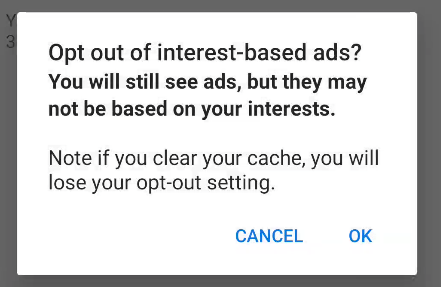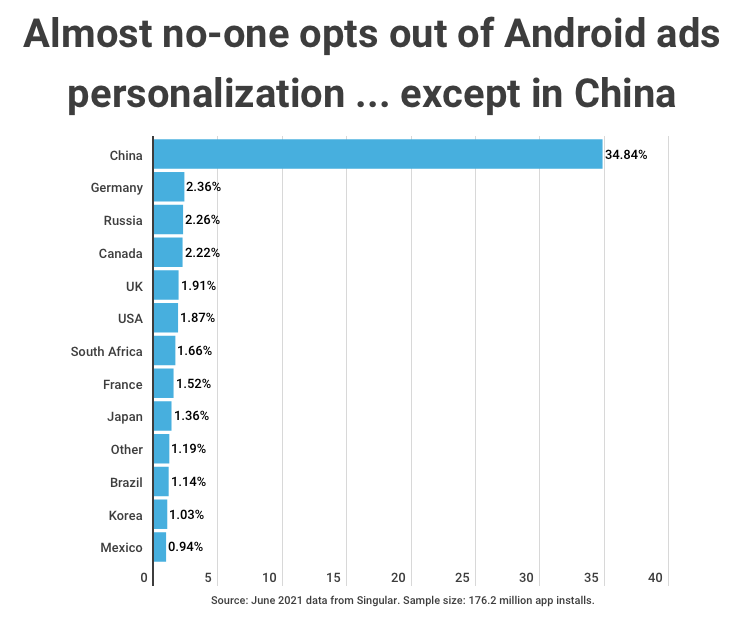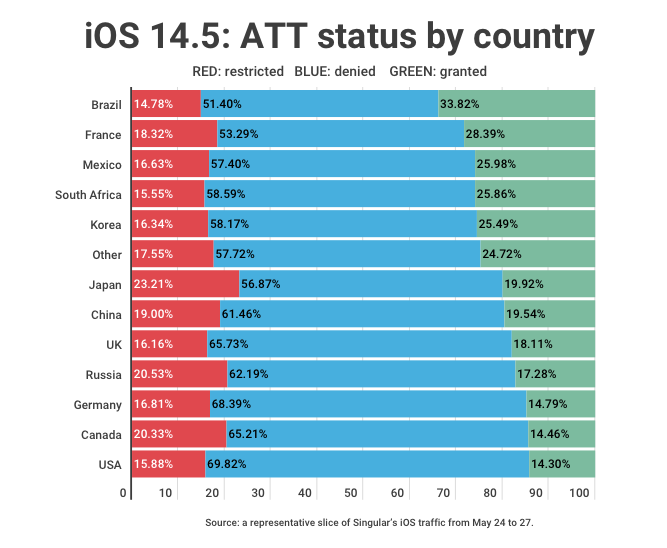Zeroing out the Android Limit Ad Tracking (LAT) will impact only 2% of devices globally
You’ve heard that Google’s making a big step towards mobile privacy by zeroing out the GAID, or Android advertising ID, for people who opt-out of ad personalization on Android. What you haven’t heard is how utterly minuscule the percentage of people that this impacts actually is.
So we checked.
And based on a recent sample of Singular data consisting of more than 176 million Android smartphones globally, only 2.08% of Android users have tunneled down into Settings -> Privacy -> Advanced -> Ads and actually turned Ads Personalization off. Most countries are in the 1-2% range, but one country is a massive outlier.
Keep reading to see the data for 12 major nations …
Google Advertising ID: what it is and what it’s used for
The Google advertising ID or Android advertising ID identifies an Android device for advertisers. Ad networks can do rate limiting based on the GAID. They can do retargeting. Marketing measurement companies like Singular can do attribution, which helps advertisers understand how successful campaigns and partners are. And advertisers can track how valuable new users or customers that they’ve acquired from various campaigns, creatives, or sources are, giving them important information for future marketing optimization.
But when you can follow an IDFA on an iOS device or a GAID on an Android device around the world by seeing where it pops up in mobile ad auctions, you can also do some shady things.

In the past, Google has essentially relied on the honor system: if an Android owner opts out of ads personalization, the advertising identifier was still available if an adtech vendor asked for it.
There’s a reason for what, on the surface, seems like an odd decision: the GAID is also used for analytics, fraud detection, and attribution. In other words, non-advertising situations. But it’s a little odd to use an advertising identifier for non-advertising purposes … and it’s even more Boy Scout to think that there are no bad actors out there who will use what’s available regardless of the guidelines and rules.
So now Google is doing what Apple has did on iOS versions pre 14.5 when people turned Limit Ad Tracking on: zeroing out the Android advertising identifier if people turn Ads Personalization off. (Note how those actions move in opposing directions but essentially do the exact same thing.)
But, very few people opt out of Ads Personalization on Android
While zeroing out the Google advertising ID is a nice gesture from Google and will increase privacy for those who care, the reality is that almost no one opts out of Android ads personalization. Literally, 98% of people globally have kept the default Android setting to personalize ads.
A couple caveats on the below data: it does not include server-to-server traffic, where Singular doesn’t see the GAID, and there are some devices where the Ads Personalization on-off setting isn’t available. Also, this particular sampling of data doesn’t include a lot of China-based data, so the massively higher opt-out rate in China isn’t impacting the global percentage very much.

Clearly, the Ads Personalization setting in Android is almost irrelevant, except in China.
Why China is such a massive outlier here I cannot say with certainty (ping me if you can) but I assume is likely due to some version(s) of Android from one or more Chinese manufacturers that ship with different defaults. Anyone can get Android source code from the Android Open Source Project and then fork it for their unique take or skin on Android, which is why Xiaomi has MIUI, Vivo has Funtouch OS, and Oppo has ColorOS.
Essentially, opting out from ads personalization on Android is a rounding error.
But it wasn’t always this way.
‘Limit Ad Tracking’ on Android used to be higher
I first studied Limit Ad Tracking on iOS and ads personalization on Android in 2016 as the Mobile Economist for TUNE, a former mobile measurement partner. (A lifetime ago!) Ad Age’s Kate Kaye picked up the story.
At that time, LAT was already falling. Across all mobile devices from both major platforms, limit ad tracking was down about 5% in a year:
Use of the limit-ad-tracking setting fell to 16.7% of devices in February from 22% in August 2015, according to Tune, which observed 1.3 billion mobile app installs by about 150 million people over seven months, from August 2015 to February 2016.
This is the first example of data measuring the use of the limit-ad-tracking feature, said Jules Polonetsky, CEO of the Future of Privacy Forum. Limit ad tracking, he continued, “despite being this central privacy control, really doesn’t get a lot of debate or discussion.”
That year, the number of Android users who had turned ads personalization off was more than double the number of iOS users who had turned Limit Ad Tracking on. (Yes, I know the opposite direction here is confusing; both actions essentially do the same thing.)
But in 2020, when I studied the same numbers for Singular, things had changed dramatically:
[In 2016] 11.4% of iOS users had turned LAT on, limiting the data that they provided to advertisers. On Android, 25.3% of Americans had switched off ads personalization, which accomplishes the same purpose.
But in 2020, we’re seeing significant changes in opposite directions. Now, ads personalization on Android is down to just 2.3% and Limit Ad Tracking on iOS is up to 31.5% — a massive swing in opposite directions on both major mobile platforms.
Here’s the data from early 2o20 in a chart:
Apple starting banging the privacy drum
Between 2016 and 2020, Apple started banging the privacy drum. Which of course is even louder now with iOS 14.5, SKAdNetwork, privacy-safe marketing measurement, a completely opt-in approach to ad measurement and tracking, a new App Privacy report in iOS 15, and Infinity War style TV ads with nosy people popping out of existence.
Not shockingly, we see that reflected in the data on app tracking opt-in rates:

(Check back on the Singular blog next week, by the way: we’ll be updating that report.)
The upshot for Android
The upshot for Android is pretty simple: Google’s change won’t impact much. It’s the right call, and some would argue overdue, and it signals a new Google approach to privacy along with FloC and other initiatives.
But for now: Android-focused growth marketers are essentially going to be doing business as usual.
Also, there’s good news: Google will be replacing the GAID with an alternative solution for use cases that are not ad personalization related. And it’s coming soon:
In July, we will provide an alternate solution to support essential use cases such as analytics and fraud prevention.
That’s good news for marketers, and it’s something that Apple might want to take a look at and consider. There are places that SKAdNetwork simply doesn’t work or offer a solution, and the industry needs privacy-safe replacements for what has been taken away.
Need to chat? We have a sofa
If you’re looking for experts to chat about next-generation marketing measurement in a confusing and ever-changing era of increased privacy and shifting technologies, we’re here to help. We’ll listen, learn, maybe offer a few condolences, and then share how Singular can help you with your unique challenges and requirements.
Growth is still possible. We can help.
Book some time, and we’ll chat. Sofas are optional.
Stay up to date on the latest happenings in digital marketing


